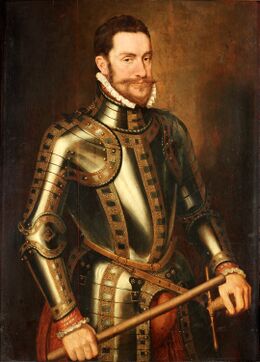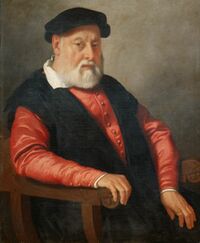Otto I of Koravia
|
| |||||||||||||||||||||||||||||
Otto Kortrevich ‘The Marshal’ (Common: Otto Kortrevich), known formally as The Baron of Koravia, or referred to simply as Otto. He was the founder of House Kortrevich and was enfeoffed the Barony of Koravia, elevating his House to Haeseni nobility for the first time since their dawning. He was the eleventh Lord Marshal of Haense, assuming the position in 1706. He is regarded for the emergence of House Kortrevich and as an acclaimed Haeseni bannerman during the late 1600s and early 1700s.
Contents
Early Life and Young Adulthood
Otto Kortrevich (1677-1778) was born to Lukas and Evelyn (Himsul) Kortrevich, as the eldest of three brothers within the Royal City of Markev, Haense. His father was a Lieutenant in the Brotherhood of Saint Karl and his mother was a physician in the Haeseni Clinic. As an only child, Otto was raised amongst his cousins.
Otto grew up in a period of peace during the reign of King Robert I. Despite this, towards his breach into adulthood, the Third Atlas Coalition War broke through; as a result, he enlisted into the Brotherhood of Saint Karl at thirteen after recruitment by Lord Marshal Rhys var Ruthern (1690). The same year he enlisted, his father was killed at the Siege of Nordengrad. Thus, his mother was left a widow and Otto was left without a father, springing him quickly into adulthood, cutting his childhood short.
Following his enlistment, his cousins followed suit. Two years after his father’s death, Otto solidified himself as the head of his family and would begin to rise through the ranks of the military. By his early twenties, his house grew twice fold and he found himself promoted to the rank of Sergeant. During this time, he and his family gained notoriety through the military and subsequently he began to form a close rapport with King Robert I and Prince Jakob Ludovar. The trio often went on hunting and fishing expeditions.
Marriage
Otto Kortrevich was married to Kaitlyn Dyer at a Haeseni war encampment in 1716, officiated by a Brotherhood chaplain. Three years later, Kaitlyn Dyer died due to childbirth. Despite the misfortune, a blessing came, as Markus Otto was born. Otto remained as a widower for the remainder of his life, choosing not to remarry.
Baron of Koravia
In 1698, the race to migrate off the continent of Atlas grew closer. Otto led as one of the commanders during the Siege of Lasthope, resulting in a resounding victory for the descendants. Regardless of such victory, the descendants' hope for survival rested on migration overseas. Successfully, the Kingdom of Haense and her surviving vassals arrived on the continent of Arcas. Soon enough, the capital city of Reza was constructed which would rise to become one of the most populous cities on the continent.
In the years following the arrival to Arcas, Otto’s house grew twice fold to a levy size comparable to that of House Kovachev during the Dukes' War. All of which coincided with the rise of Nikolaus and Rodrik Kortrevich; who were destined to become future Knights of Haense and the rise of Martin, Duncan, Damon and Erik Kortrevich who rose through the ranks of the military at an expeditious rate. In recognition of such, Robert I sought to reward the youthful Otto for his house’s rise to prominence. In 1706, Otto was named the eleventh Lord Marshal of Haense. Unfortunately, Robert I passed before carrying out his second wish, the enfeoffment of a Barony to Otto. Alas, in the year following, his son, Marius II carried out his father’s wishes and elevated House Kortrevich to nobility.
From 1698 to 1715, the House of Kortrevich cemented itself in the Kingdom as a house with great promise. In 1707, Marius II codified the re-institution of the Royal Duma. Otto was one of the founding lords of the Royal Duma. Known as a staunch Centralist. He played a hand in initial lasting changes, including term limits, session lengths and election laws. During the War of Two Emperors, Otto preserved the reputation of his house as he dealt with the controversies of the betrayal of his own kin, the likes of which include; Ser Rodrik, Ser Cassius and Lilliana Kortrevich. All of whom were disowned by Otto. There was rumor spread that Otto killed Ser Cassius sometime during the war, though nothing came to confirm its validity.
Towards the latter half of his reign as Baron, Otto encountered equal praise and criticism. Some posed criticism for both his increasingly stagnant role in his House during his waning years as patriarch and his part in losing the war. This prompted Otto to narrowly evade three assassination attempts. On the other hand, others gave him praise for his leadership as Lord Marshal in ending the war through the Treaty of Reza. During his reign as Baron, relationships were strengthened amongst other houses; notably with House Amador. Both Otto Kortrevich and Henrik Amador established the Kortrevich and Amador Trading Company which became a staple in the city for many years.
As Otto led House Kortrevich for thirty-one years, he appeared in numerous trials, serving as both the defense and prosecution. In 1707, in his first year as Lord Marshal; Otto testified in the Crown vs. Ludovar trial against his former close confidant Prince Jakob Ludovar. Notably in 1725, he testified in the Crown vs. Kortrevich trial against his own brother, Erik Kortrevich. In 1719, his first and only son Markus Otto was born, who was mothered by Kaitlyn Dyer. Unfortunately she died as a result of childbirth. Otto was absent in much of his son’s early life, being primarily raised by the likes of Terrence May and his elder kin.
As a reward of his steadfast service and his House’s prominent standing in the Kingdom, Andrew III endowed the construction of a military outpost to serve as the seat of House Kortrevich. Otto was responsible for the fort’s construction. As a result, the fortress remained functional and served as an active outpost for the Brotherhood for ten years until Andrew IV expanded the city south. It was later decommissioned and torn down. In its place, farmland was tilled. Initially, Otto expressed indignation regarding the decision but was quickly satisfied after acquiring the second-largest noble estate in Reza.
By 1738, Otto resigned and abdicated his baronial title to his son Markus. It was with reluctance though, as talks circulated amongst the Aulic Council that House Kortrevich would be elevated to a Duchy or a County.
Lord Marshal of Haense
From 1696 to 1706, the Haeseni martial sector experienced significant decline under the leadership of Lord Marshal Sergei Stafyr. Overall, recruitment efforts shrunk dramatically and morale sunk to all time lows. Robert I, known for his peaceful reign, acknowledged the importance of a strong standing army to maintain peace. In recognition of this, Sergei Stafyr was later relieved of his duties. Months later, he would be assassinated by unknown assailants.
Having been a Lieutenant in the military, Otto was chosen to be named the eleventh Lord Marshal of Haense. He was tasked with reconstructing the military from the ground up. In his first four years, he accelerated recruitment efforts prompting the military to increase to 3,600 infantry men and 400 cavalry units. In doing so, morale amongst the ranks of the military were elevated, but much was still to be done. In an attempt to restore culture within the military, Otto spent time reintroducing various teachings and training regimens, which were taught by Lord Marshal Rhys var Ruthern. Successfully, the military adopted a Brotherhood-esque culture.
By 1710, tensions began to rise between the Kingdom of Haense and the Empire of Renatus. In preparation for war breaking out, Marius II commissioned a new military order to be established to further continue Otto’s reforms of the military. Within a few months, the second Order of the Haeseni Royal Army was established. Despite maintaining the near identical structure to its precursor, it introduced various new improvements. In the first three years, the newly reformed military saw an increase to 4,200 infantry men and 800 cavalry units.
From 1715 to 1721, the War of Two Emperors broke out. With the Kingdom of Haense supporting Emperor Joseph I of the Holy Orenian Empire. In the first year, the opposing armies clashed at the Battle of Upper Rodenburg, resulting in a resounding victory for the Holy Orenian Empire. Despite victory early on in the war, the Kingdom of Haense’s morale plummeted following the defeat at the subsequent Battle of Lower Rodenburg. Nevertheless, under the experienced command of Otto, the war carried forward. Some battles were won by small margins, others were lost by large margins.
Ultimately, the determinant Siege of Helena took place in 1716. Similar to the start of the war, the start of the Siege began with great success for Oren. Otto and his cousin Ser Nikolaus were among the few Haeseni commanders who led various successful commands. Oren maintained an advantage of numbers over Renatus towards the end of the siege. Despite this, one final charge was issued, which resulted in Oren’s unexpected defeat. Afterwhich, Emperor Joseph I sounded a retreat and the city of Helena managed to be held by Renatus by slim odds.
By 1719, the Kingdom of Haense declared independence from the Holy Orenian Empire and sued for peace. The war continued on regardless, no peace was made. The military’s morale fell significantly further and the desire to end the war grew apparent. As a result of the vast casualties of war, the military’s chain of command fell into complete disarray. During the waning years of the war, the military’s strength was a fraction of its former self. Otto felt it was necessary to resort to defensive measures towards the end of the war. Because of this, he faced vast criticism and was labeled a coward for "[...] [his] unwillingness to win the war."
Despite criticism, Andrew III acknowledged the military’s depleted strength. So, for the remainder of the war, the Kingdom of Haense remained on the defensive. Months later, negotiation of peace made headway and by 1721, the Empire of Renatus and the Kingdom of Haense culminated in the Treaty of Reza. Nevertheless, as the war concluded, Otto’s role as Lord Marshal was placed into jeopardy. The young Andrew III recognized Otto’s early successes as Lord Marshal, but pointed out his eventual failures towards the end of the war. As Otto neared his fiftieth name day, he willingly resigned, not before aiding in the later establishment of the second Order of the Brotherhood of Saint Karl. In 1724, Otto Kortrevich resigned after eighteen years as Lord Marshal and was succeeded by Grand Prince Otto Alimar.
In 1746, at the age of sixty-eight, Otto formally retired from military service with the role of Commandant. His last major military engagement was the Battle of Hangman's Bridge, resulting in a resounding victory for the Kingdom of Haense.
Later Life and Death
In 1759, Otto retired from public life. In the succeeding years, he would publish various books relating to war command, military culture and military strategies. For the vast majority of his life, he served the Kingdom of Haense through steadfast military service. Though, as he withdrew into a secluded retirement, Otto’s hand was no longer bound to a steel blade, it was now bound to a paper and quill.
Growing up, he took a great interest in learning the native language of New Marian. He became fluent in the language before his eleventh name day. Unfortunately, studying the language became an afterthought as his priorities shifted towards enlistment into the military. Nevertheless, Otto maintained fluency in the language of New Marian throughout his life. Oftentimes, catching royals the likes of; Robert I and Marius II by pleasant surprise.
By the time he retired from public life in 1759, he had already breached into his eighties. Regardless of such, he maintained a healthy lifestyle, living off the land in Korstadt. In 1769, he was inducted in the Order of Queen Maya and the Lily as a Kossar for his military service and as Lord Marshal of Haense. From 1759 to 1774, Otto compiled an assortment of journals that completed the translation of the entirety of New Marian for the first time since the language’s inception. In 1776, these translations were organized by him and his grandson, Juliyus; later being published to become one concise document. Twenty years following its publication, literacy rates for New Marian increased by a staggering rate in the Kingdom.
In the years following, Otto’s health began to deteriorate significantly. Otto began to make fewer public appearances, being restricted to bedside. In 1778, Otto died of natural causes at the age of one-hundred-and-one. Posthumously, Otto was promoted to a Hauchkossar in the Order of Queen Maya and the Lily for his extensive linguist contributions to the Kingdom paired with his steadfast military service of fifty-six years.
Titles, Styles and Honors
Titles and Styles
- 1706-1724: His Excellency, Lord Marshal of Haense
- 1707-1738: His Lordship, Baron of Koravia
Honors
- 1778: HKML, Hauchkossar of the Order of Queen Maya and the Lily
- 1769: KML, Kossar of the Order of Queen Maya and the Lily
Formal Title
The formal title of Otto is: Lord Otto Kortrevich, Lord Marshal of Hanseti-Ruska, Baron of Koravia, HKML of the Order of Queen Maya and the Lily.
Issue
| Name | Birth | Death | Marriage | Notes |
|---|---|---|---|---|
| Markus I of Korstadt | 1719 | 1793 | Winnifred of Muldav | Firstborn child of Otto I and Kaitlyn Dyer. Successor of Otto I.
|



